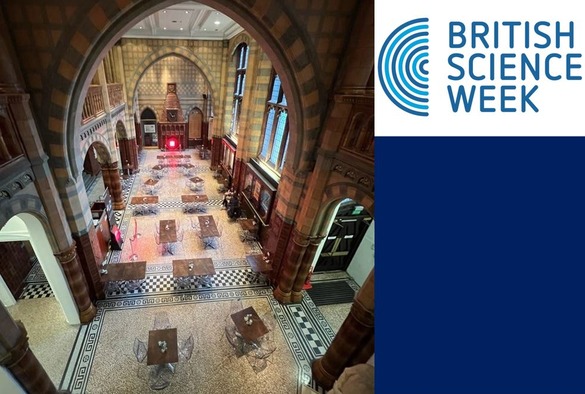Victoria Gallery and Museum, British Science Week – Science Fair

Members of the Physics Outreach Group ‘radiated’ their passion for their subject on Saturday 16th February as part of the Victoria Gallery & Museum’s Time themed Science fair marking the end of British Science Week 2024.
Hundreds of visitors of all ages passed through the event (~500) where physics outreach delivered demonstrations and activities around the subject of radiation.
In addition to activities provided by the Vets school, the Cockroft Institute’s ‘Surfatron’ and many more, the Physics Outreach Group guided visitors’ understanding of many aspects of radiation through exploring our hands-on demonstrations including:
Measuring the radioactivity of various samples. Many samples are everyday objects including some food items such as bananas and ‘Lo-Salt’ (Potassium-40) and brasil nuts (Radon and Barium) which all contain traces of radioactive isotopes. Another radioactive source we encounter every day which significantly contributes to safety and saving lives are smoke alarms which contain a radioactive source such as Americium-241.
Visitors were allowed to use our G-M Counters (Geiger Muller Tubes) to measure radiation being emitted by these samples. The G-M Detectors will emit a ‘click’ when it encounters a radioactive particle with the more common and weak samples giving just a few clicks over a time period of about 10 seconds.
Many visitors were very excited to also measure some ‘more radioactive’ samples we brought from the lab such as Uranium glass (glass doped with uranium), rocks found in Cornwall (lots of natural radioactivity in the rocks), soil samples from Chernobyl. The clicks from the G-M Detectors certainly increased for these!

Radioactive samples and G-M Tubes for members of the public to test.
Many visitors were shocked that one of the most radioactive samples we had were 2 very old watches with ‘glow in the dark’ Radium paint on the dials. Radium has a half life of 1600 years which means it takes that amount of time for half of the atoms to decay which is why these samples in particular are still very radioactive. Many of the workers who painted these dials died of radiation related illnesses because at the time we did not understand the dangers of radioactivity. Radium was used not only for this but also for other tasks such as washing powder for clothes and even teeth whitening!
Today we have a very deep understanding of radiation, its dangers, its benefits and most importantly how to handle it safely. The SRP (Society for Radiological Protection) is one network of radiation specialists that regulates and monitors safe use of radioactive sources. Any institution that own or handle sources, which have to be registered on the Radiation Protection Council’s database, must have a trained RPO (Radiation Protection Officer) who is responsible for ensuring their source/s are safely used and stored.
Chattery Teeth Spontaneous decay (Tooth Decay). One way of modelling spontaneous decay is by using coin flips, head’s decays, tails does not. If this is plotted on a graph, due to the nature of probability, we will end up with a curve exactly like a measured decay curve. This fun demonstration does the same thing however we use wind-up chattery teeth with coin containers on their backs. As the teeth hop along they drop the coins which can then be counted to see which have decayed (heads) and which haven’t (Tails).

Chattery Teeth’ for our ‘Tooth Decay’ Activity
Target the Tumour. A major benefit and use of radiation today are in medicine to treat illnesses such as cancer. One of the biggest challenges for radiotherapists and medical physicists is to target only ‘bad’ cells whiles leaving healthy cells untouched. In this activity mini-balloons representing ‘bad’ cells are stuck on to our glamourous volunteers, C3PO and Chewbacca. Visitors had a lot of fun using Nerf guns to target the balloons whilst trying to avoid hitting the bodies anywhere else. There certainly were some extremely good sharpshooters with one youngster even hitting Chewbacca’s balloon square-on causing it to fly off!

C3P0 (far left) and Chewy (far right) with some of the amazing undergraduate student volunteers, L-R Emma Stanley, Grace Buzzard and Alice Cartridge.
Measure the Decay (Real Time). Visitors were able to contribute to our ‘real time’ measurement of a radioactive sample decaying throughout the day. We had an Indium source which has a relatively short Half-Life (~50 minutes) meaning we could see it completely decay over the course of the event. Visitors were asked to take a ‘count’ of how many decays were detected using a G-M counter device over a 10 second period. This would then be plotted by the visitor onto a graph.
By the end of the event we had a plotted data series showing the expected decay curve.

Our Indium Source (Yellow case) next to the GM tube (Silver cylinder) connected to the counter (Blue box with numbers). We also had ‘Dosimeters’ (Orange devices) to measure how much or a radiation dose someone may get at different distances.

Our Indium decay curve plotted throughout the day by visitors and Postgraduate students Faye Rowntree (Left) and Robyn Wells (Right) with the finished graph.
Further information on other aspects of radiation were provided in a series of informative slides developed by the Physics Outreach Group in collaboration with the SRP which explored: What it is, where it comes from, how we decide if something is dangerous or safe, benefits and uses and how we use understanding to protect ourselves by considering the 3 principles of radiation protection, time exposed, distance to the source and shielding.
Thanks to all of our amazing volunteers who worked incredibly hard to ensure all of our visitors were able to get involved and learn more about radiation!
Staff member: Sarah Annand (TEL Officer) Postgraduate Students: Faye Rowntree (Physics) and Robyn Wells (Chemistry) and
Undergraduate Students: Helena Grabam, Bekah Roden, Sam Bowering, Alice Cartridge, Emma Stanley and Grace Buzzard.